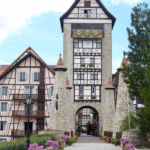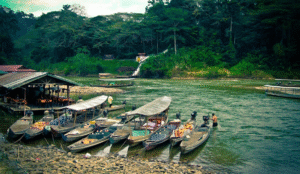Ipoh City Uncovered: Malaysia’s Delightful Hidden Destination
When travelers talk about Malaysia, the usual names that come to mind are Kuala Lumpur, Penang, Langkawi, or Malacca. Yet, tucked in the heart of Perak lies Ipoh city, a destination that is slowly gaining the recognition it deserves. Once a tin-mining boomtown during the British colonial era, this charming city is now a perfect blend of heritage, culture, nature, and food. With its colonial-era architecture, limestone hills, vibrant coffee shops, and laid-back charm, Ipoh city has all the ingredients to surprise visitors who give it a chance.
This article will take you on a journey through the hidden corners of Ipoh city—from its rich history to its modern revival—while giving you a comprehensive guide on what to expect and how to make the most of your visit. Along the way, you’ll also discover the best things to do in Ipoh, whether you’re here for a short trip or planning to stay longer.
Frequently Asked Questions (FAQ)
1. What is the difference between Traditional Chinese and Cantonese?
Traditional Chinese refers to the written script, while Cantonese is a spoken language or dialect. Traditional Chinese characters are used in writing, especially in regions like Hong Kong and Taiwan. Cantonese, on the other hand, is a spoken language with its own pronunciation, tones, and expressions. In Malaysia, Cantonese speakers often use Traditional Chinese in writing, especially for signage, advertisements, or religious texts, but they speak in Cantonese.
2. Which part of Malaysia speaks Cantonese?
The Klang Valley region, including Kuala Lumpur and Selangor, has the highest concentration of Cantonese speakers. Other notable areas include Ipoh (Perak) and Seremban (Negeri Sembilan). These areas were historically settled by Chinese immigrants from Guangdong, many of whom spoke Cantonese. As a result, the dialect remains widely spoken in these urban centers today.
3. Is Cantonese widely spoken in Malaysia?
Yes, Cantonese is one of the most widely spoken Chinese dialects in Malaysia, particularly in urban and commercial hubs. While Mandarin is the official language used in Chinese education and media, Cantonese remains vibrant in daily communication, especially among older generations and within traditional Chinese communities. It also enjoys a strong presence in media through local radio, TVB dramas, and YouTube content.
4. How quickly can you learn Cantonese?
Learning Cantonese depends on your language background, exposure, and dedication. On average:
- With consistent study and practice, a beginner could start holding basic conversations in 6 to 12 months.
- Knowing Mandarin or another Chinese dialect can help shorten the learning curve due to shared vocabulary.
- However, Cantonese is tonal, with six to nine tones, making pronunciation a key challenge for new learners.
- Watching Malaysian or Hong Kong dramas, speaking with native speakers, and using language apps can accelerate your learning.
5. What makes Cantonese culture unique?
Cantonese culture is known for its vibrant traditions, expressive language, rich cuisine, and strong family values. Key elements include:
- Culinary traditions like dim sum, roast meats, and herbal soups.
- Linguistic expression through idioms, proverbs, and tone-rich storytelling.
- Performing arts such as Cantonese opera and lion dances.
- A strong emphasis on filial piety, respect for elders, and maintaining community ties.
In Malaysia, this culture is further enriched by local influences, resulting in a truly unique version of Cantonese identity.
The Story Behind Ipoh
To understand Ipoh city, you need to go back to its origins. The name “Ipoh” comes from the local tree called pokok ipoh, which produces poisonous sap traditionally used by indigenous people to coat blowpipe darts. The real transformation of Ipoh city began in the late 19th century, when the area became one of the richest tin-mining hubs in the world. Wealth poured in, attracting traders, miners, and entrepreneurs from China, India, and beyond.
This influx of cultures shaped the unique identity of Ipoh city. Colonial influences can still be seen in its old shophouses, grand train station, and municipal buildings. The British once dubbed it the “City of Millionaires,” thanks to the prosperity tin brought to its streets. After the industry declined, however, the city entered a quiet period, almost forgotten compared to Malaysia’s flashier destinations.
Today, Ipoh city is making a comeback. Instead of mining wealth, it now thrives on tourism, heritage preservation, and culinary fame. It’s a reminder that cities, like people, can reinvent themselves with grace.
Why Visit Ipoh?
The appeal of Ipoh city lies in its balance. It’s not overly crowded like Kuala Lumpur, nor as heavily touristed as Penang. Instead, it feels authentic, with a pace of life that invites you to slow down. Heritage lovers can explore colonial-era streets and restored shophouses, nature seekers can head to the limestone caves and lush hills surrounding the city, and foodies will fall in love with its vibrant street food culture.
Moreover, Ipoh city has an unpolished charm. Its faded buildings, friendly locals, and relaxed lifestyle make it feel approachable. For travelers seeking genuine experiences, this city offers countless stories and flavors to uncover. And for those wondering about things to do in Ipoh, the list is longer than you might expect.
Colonial Architecture and Heritage Charm
One of the first things that strikes visitors in Ipoh is its architecture. Walking around the old town is like stepping back in time.
- Ipoh Railway Station– Known as the “Taj Mahal of Ipoh,” this majestic building was completed in 1917. Its whitewashed walls, Mughal-inspired domes, and colonial elegance make it one of the most photographed landmarks in Ipoh city.
- Birch Memorial Clock Tower– Built in 1909, this clock tower honors James W.W. Birch, the first British resident of Perak. Surrounding murals depict the march of civilization, making it both historic and symbolic.
- Concubine Lane– Once home to mistresses of wealthy tin miners, this narrow alley has transformed into a bustling tourist street lined with cafes, souvenir shops, and murals. It’s now one of the most popular stops for anyone looking up things to do in Ipoh.
Every corner of old town tells a story—from fading murals to vintage shop signs. As you wander, you’ll notice the mix of Chinese clan houses, Indian temples, and colonial shophouses that reflect the multicultural past of Ipoh city.
The Food Capital You Didn’t Expect
If there’s one thing Ipoh is undeniably famous for, it’s food. Locals will proudly tell you that no trip is complete without tasting its culinary treasures.
- Ipoh White Coffee– Originating from this very city, white coffee is made by roasting coffee beans with palm oil margarine, then served with sweet condensed milk. The result is a smooth, aromatic drink that has put Ipoh city on the global coffee map.
- Bean Sprout Chicken (Nga Choi Kai)– This iconic dish pairs juicy steamed chicken with crunchy bean sprouts, drizzled with soy sauce and sesame oil. It’s a simple yet unforgettable taste of Ipoh city.
- Salted Chicken (Yim Kok Kai)– Baked with Chinese herbs and wrapped in parchment paper, this local specialty is both savory and aromatic.
- Street Food Scene– Don’t miss tau fu fah (silky beancurd pudding), curry noodles, and the famous pomelo fruits grown in nearby Tambun.
For foodies searching for things to do in Ipoh, hopping from kopitiam to hawker stall is an adventure on its own. Each meal is a story of tradition, migration, and local pride.
Ipoh’s Natural Wonders
Beyond its streets and cafes, Ipoh is blessed with dramatic landscapes. Encircled by limestone hills and caves, it’s a playground for those who love nature and photography.
- Kek Lok Tong Cave Temple– Nestled inside a limestone cavern, this Buddhist temple opens up to stunning gardens and ponds. The contrast between sacred statues and rugged cave walls makes it unforgettable.
- Perak Cave Temple– Featuring giant golden Buddhas and colorful murals, this temple also offers a steep climb to a viewpoint overlooking Ipoh.
- Gua Tempurung– Located just outside the city, this is one of Malaysia’s largest limestone caves. With guided tours ranging from easy walks to adventurous spelunking, it’s a highlight for explorers.
- Kinta Riverfront– Perfect for evening strolls, the riverfront area is lit up with colorful lights and offers a glimpse of modern leisure in Ipoh.
These spots highlight the unique blend of spiritual, cultural, and natural attractions that make Ipoh city stand out.
Beyond the City: Day Trips Around Ipoh
Ipoh also serves as a great base for exploring nearby attractions:
- Kellie’s Castle– A mysterious unfinished mansion built by Scottish planter William Kellie-Smith in the early 20th century. It’s surrounded by legends and ghost stories, making it a must-see.
- Tambun Hot Springs– A relaxing spot where travelers can soak in mineral-rich waters. Nearby, the Lost World of Tambun theme park is a family-friendly attraction with water rides and natural hot springs.
- Royal Belum State Park– About a two-hour drive from Ipoh city, this pristine rainforest is home to endangered species, indigenous tribes, and breathtaking nature.
These side trips show that Ipoh is more than a single-destination stop—it’s a gateway to wider Perak adventures.
People and Culture of Ipoh
The heart of Ipoh is not just its buildings or food but its people. The city’s multicultural makeup—primarily Malay, Chinese, and Indian—creates a welcoming atmosphere. Each community contributes to the festivals, cuisine, and traditions that make Ipoh city unique.
Whether you’re chatting with a coffee shop owner, bargaining at a local market, or being guided through a temple, the warmth of the people leaves a lasting impression. This human connection is what transforms sightseeing into something personal.
Practical Travel Tips for Ipoh
- Getting There– Ipoh city is about 2.5 hours by train or car from Kuala Lumpur, making it an easy weekend trip. The Electric Train Service (ETS) is a comfortable option.
- Best Time to Visit– The city enjoys warm weather year-round, but December to February is cooler and less humid.
- Where to Stay– From heritage boutique hotels in the old town to modern resorts, accommodation in Ipoh city fits different budgets.
- Getting Around– The old town is best explored on foot, but ride-hailing apps and taxis are available for longer distances.
Knowing these basics ensures you get the most out of your stay in Ipoh city.
Final Thoughts: Ipoh’s Quiet Magic
In many ways, Ipoh city is like a well-kept secret. It doesn’t try to impress with skyscrapers or flashy malls, yet it leaves an imprint on those who explore its streets, taste its food, and breathe its air. The balance of heritage and modernity, calmness and vibrancy, tradition and creativity makes Ipoh city an underrated gem in Malaysia’s travel map.
Whether you’re a culture buff, a foodie, a history enthusiast, or just someone seeking a slower pace of travel, this city has something special for you. And if you’re wondering about the best things to do in Ipoh, the answer is simple: immerse yourself, wander with curiosity, and let the city reveal its treasures to you.
So next time you plan your trip to Malaysia, don’t overlook Ipoh city. It may not shout the loudest, but it whispers stories that you’ll carry long after you’ve left.





